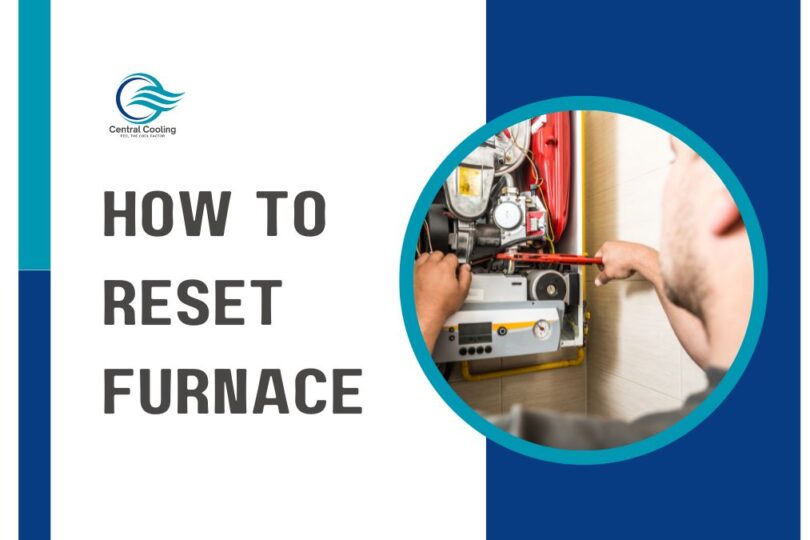Introduction:
Resetting a furnace involves various steps, depending on the type and model of the furnace you have. It’s important to note that if you are not comfortable or familiar with the process, it’s best to contact a professional HVAC (heating, ventilation, and air conditioning) technician to avoid any safety hazards. Here’s a comprehensive guide on how to reset a furnace, covering various common types:
Table of Contents
ToggleHow To Reset Furnace Safely:
A) Gas Furnace Reset:
Check For Gas Leaks
Before doing anything, ensure there are no gas leaks. If you smell gas, leave the area immediately and contact your gas company.
Turn Off The Furnace:
Locate the furnace switch or breaker and turn it off.
Wait For 5 Minutes:
Allow the furnace to remain off for at least five minutes. This ensures any residual gas clears out.
Turn On The Furnace:
Turn the furnace switch or breaker back on.
Set Thermostat:
Set the thermostat to a temperature higher than the current room temperature. This should trigger the furnace to start.
Check for Operation:
Listen for the sound of the furnace igniting. If it doesn’t start or if you encounter any issues, it’s advisable to call a professional technician.
B) Oil Furnace Reset:
Check Oil Levels
Ensure there is an adequate supply of oil in the tank.
Press Reset Button:
Many oil furnaces have a reset button. Press it only once. If the furnace doesn’t start after one reset, it’s time to call a professional.
Bleed the Fuel Line:
If the furnace has run out of oil, you may need to bleed the fuel line. This involves opening a valve to release trapped air. Consult your furnace’s manual or seek professional help for this.
For information on whether you can put diesel in an oil furnace, read our blog.
C) Electric Furnace Reset:
Turn Off Power
Locate the circuit breaker for the furnace and turn it off.
Wait for 5 Minutes
Allow the furnace to remain off for at least five minutes.
Turn On Power
Turn the circuit breaker back on.
Set Thermostat
Set the thermostat to a temperature higher than the room temperature. The electric furnace should start.
Check for Operation
If the furnace doesn’t start or if there are any issues, consult a professional technician.
D) Heat Pump Reset:
Check the Thermostat
Ensure the thermostat is set to the desired temperature.
Turn Off Power
Locate the circuit breaker for the heat pump and turn it off.
Wait for 5 Minutes
Allow the heat pump to remain off for at least five minutes.
Turn On Power
Turn the circuit breaker back on.
Set Thermostat
Set the thermostat to a temperature higher than the room temperature.
Check for Operation
Monitor the heat pump to see if it starts working. If there are issues, contact a professional.
Common Tips For All Furnace Types:
Check Air Filters
Dirty air filters can cause furnace malfunctions. Replace or clean them regularly.
Inspect Vents and Ducts
Ensure that vents and ducts are clear of obstructions.
Regular Maintenance
Schedule regular professional maintenance to keep your furnace in good condition.
Read the Manual
Refer to your furnace’s manual for specific instructions and troubleshooting tips.
Additional Troubleshooting Steps:
Inspect Venting System
Ensure that the venting system is clear of obstructions. Blocked vents can cause the furnace to shut down for safety reasons.
Check Gas Supply (Gas Furnace)
Ensure that the gas supply to the furnace is not interrupted. Check other gas appliances in your home to see if they are working.
Inspect Ignition System (Gas Furnace)
If your gas furnace has an electronic ignition system, check for any issues. Follow the manufacturer’s guidelines for troubleshooting the ignition system.
Thermostat Battery
If your thermostat uses batteries, check and replace them if necessary. A low battery could prevent the thermostat from signaling the furnace to operate.
Inspect Wiring
Visually inspect the wiring for any signs of damage or loose connections. If you find any issues, it’s essential to address them carefully or seek professional help.
Reset Limit Switch (Gas and Electric Furnaces)
Some furnaces have a limit switch that can trip if the system overheats. Follow the manufacturer’s instructions to reset the limit switch.
Review Manufacturer’s Documentation
The user manual or technical documentation provided by the manufacturer is a valuable resource. It often includes troubleshooting guides and specific instructions for your furnace model.
General Safety Precautions:
- Turn Off Power: Before performing any reset, turn off the power to the furnace. Locate the power switch or circuit breaker associated with the furnace and switch it off.
- Wait for 5 Minutes: After turning off the power, wait for at least 5 minutes. This allows any residual electrical charge to dissipate and gives the furnace’s control board time to reset.
Remember, if you encounter any issues or are unsure about the reset process, it’s always best to consult a professional HVAC technician. Performing incorrect procedures can lead to safety hazards and further damage.
When To Seek Professional Help:
If you’ve followed the troubleshooting steps and the furnace still doesn’t operate correctly, or if you encounter any of the following situations, it’s time to call a professional HVAC technician:
- Strange Odors: Unusual smells like gas or burning odors can indicate a serious problem.
- Unusual Sounds: If you hear banging, screeching, or other unusual noises from the furnace, it may indicate a mechanical issue.
- Repeated Failures: If you find yourself resetting the furnace frequently, there may be an underlying issue that requires professional attention.
- Visible Damage: If you notice any visible damage to the furnace components, wiring, or other parts, do not attempt to repair it yourself. Call a professional.
Regular Maintenance:
To prevent future issues, consider scheduling regular maintenance for your furnace. A professional HVAC technician can inspect and clean the system, identify potential problems, and ensure optimal performance.
Remember, safety is paramount when dealing with furnaces. If you ever feel uncertain or uncomfortable during the troubleshooting process, do not hesitate to contact a licensed HVAC professional. They have the expertise and tools to diagnose and address furnace issues safely.
Conclusion:
Resetting a furnace can be a complex process, with each type requiring specific steps tailored to its mechanisms. Safety should always be the top priority, and if you’re uncertain about any aspect of the reset procedure, it’s crucial to enlist the expertise of a certified HVAC technician to mitigate risks and ensure the proper functioning of your heating system. By following manufacturer guidelines and adhering to safety protocols, you can effectively troubleshoot and reset your furnace, maintaining a comfortable and safe environment within your home. Additionally, prioritizing regular maintenance and promptly addressing any issues that arise can prolong the lifespan of your furnace, promoting efficient operation and reducing the likelihood of costly repairs down the line. Remember, when it comes to your furnace, investing in professional care and proactive maintenance is key to preserving its performance and safeguarding your household’s well-being.
Disclosure: We may get commissions for purchases made through links in this post.








